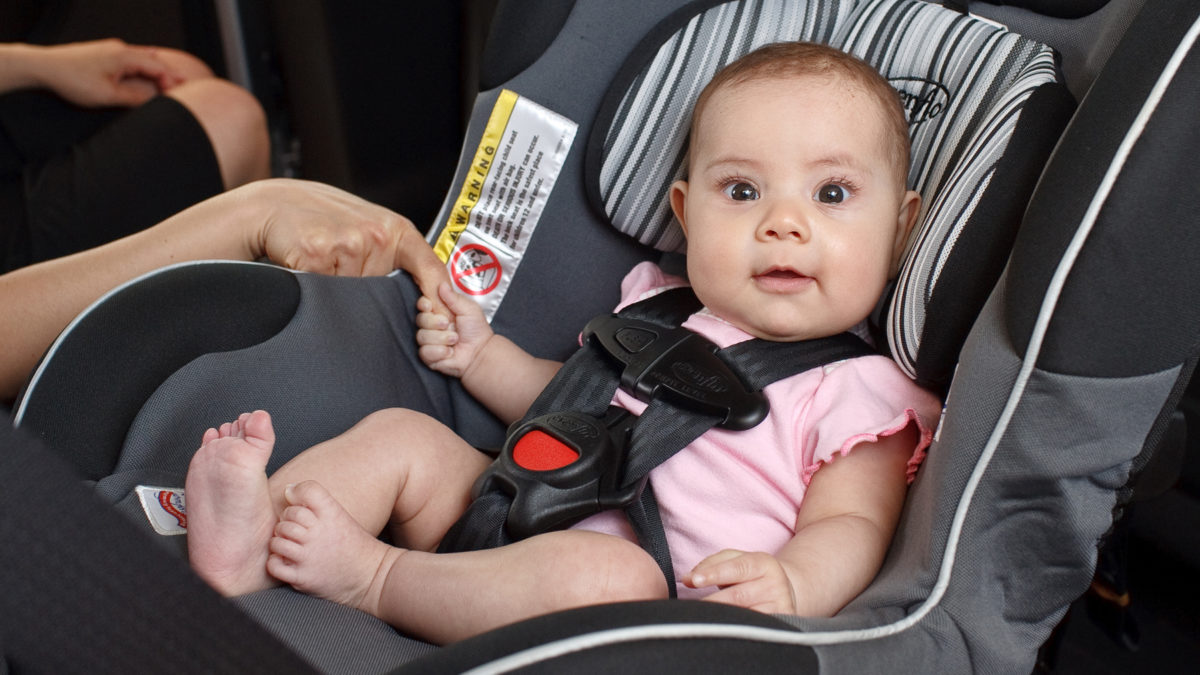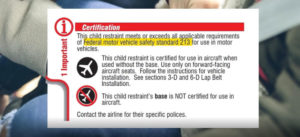It’s Child Passenger Safety Week! Here’s everything you need to know about car seat safety.

This week we’re celebrating Child Passenger Safety Week. To help families and caregivers better understand the importance of car seat safety, we’re sharing several tips and tricks from Safe Kids Worldwide, the leading organization dedicated to keeping kids safe.
Car crashes and road injuries are the leading cause of preventable deaths and injuries to children in the United States—and more than 50 percent of car seats are not used or installed correctly. When a child’s car seat is installed correctly, it’s shown to reduce the risk of death by as much as 71 percent.
Keep reading to learn how to protect your child with the proper car seat safety techniques.
Step 1: Buying the Proper Car Seat
There are three main types of car seats: Rear-facing, forward-facing, and booster seats. When buying your child’s first car seat, you’ll want to make sure that the seat fits your child’s current size and age, fits correctly in your car, and that the seat can be properly installed and used correctly each time.
Even though there are endless options, particularly in terms of aesthetics and designs, it’s important to make sure your car seat has the U.S. Federal Motor Vehicle Safety Standard 213 (FMVSS 213) product label somewhere on the seat. Despite differences in cost, you can rest assured that all car seats that have the FMVSS 213 label are equally safe and secure for your child when used correctly.

- Rear-facing car seat. This is your child’s very first car seat, typically used for kids under 40 pounds. This car seat features a harness, so in case of an emergency, it cradles and moves with your child to reduce stress on the neck and spinal cord. Infant car seats, convertible car seats, and all-in-one seats are all types of rear-facing seats.
- Forward-facing car seat. When your child outgrows the rear-facing car seat by weight or height limitations, transition them to a forward-facing car seat with a harness and top tether that limits your child’s forward movement in the event of a crash. Convertible seats, combination seats, and all-in-one seats are all types of forward-facing seats.
- Booster seat. Once your child outgrows the weight or height limitations on their forward-facing car seat, move them to a booster seat. This seat raises and positions your child, so the vehicle’s lap-and-shoulder belt fits properly over the strong points of a child’s body—the hips and across the chest. Booster seats can be bought as backless or with high backs. Combination and all-in-one seats can also turn into boosters.
Once you’ve determined the right seat for your child, read the weight, height, and age limitations to make sure the car seat is right for your child. If you’re buying online, you can find these details under “specifications” or “specs.” If you’re looking at a car seat in-person, locate the expiration date—you can usually find this on the car seat label or imprinted on the plastic itself.
Try to avoid purchasing a used car seat. Although you’ll often see used car seats on Facebook Marketplace or Craigslist, it’s best to avoid purchasing a used car seat for your child unless you:
- Personally know who has used the seat and can be 100% it has never been in a car crash
- Can view the labels and determine that the seat has not been recalled
- Can prove that it is not beyond its expiration date
Without knowing the history of the car seat—and if it was in an accident—you could get a seat that is unsafe or expired.
Register your seat. Complete the registration card that accompanies your car seat or booster seat. By registering, the car seat manufacturer will automatically notify you if there is a safety recall.
Step 2: Installing Your Car Seat
Installing your car seat is often one of the biggest challenges. When installing your car seat, always refer to the specific car seat manufacturer’s instructions and read your vehicle owner’s manual on how to install the car seat.
Use the seat belt or latch: There are two traditional ways to secure a car seat in a vehicle—either the seat belt or by using lower anchors and tethers for children (LATCH) to attach the car seat to the vehicle.
Lower anchors have weight limits set by the vehicle and car seat manufacturers. You can determine the lower anchor weight limit by checking the warning label or the installation diagrams, found on the side of your child’s car seat.
Consult this video for details on how to secure your child’s car seat.
Do the inch test. A properly installed car seat shouldn’t move more than one inch front to back or side to side when pulled. This applies to both front-facing and rear-facing car seats.
Watch this video for details on the Inch Test.
For professional help, Safe Kids Onslow County is here to help. If you would like help installing your car seat, one of our car seat technicians can help.
Step 3: Knowing When to Change Your Child’s Car Seat
When is the right time to change your child’s car seat? Although some kids might want to transition to a “big kid” car seat sooner rather than later, don’t be in a rush.
To maximize your child’s safety, keep your child in the car seat for as long as possible—unless your child reaches the maximum height and weight limitations set by the manufacturer.
- Rear-facing car seats. Keep your child in a rear-facing car seat until they reach the top height or weight limit allowed by your car seat manufacturer. Keeping your child in a rear-facing car seat is the best way to keep them safe. The best practice is until they are at least two years old—but the longer, the better.
- Forward-facing car seats. Once your child reaches the weight or height limit for rear-facing car seats, it’s time to move the convertible seat forward-facing or use a forward-facing car seat with a 5-point harness and top tether. Be sure to check your car seat manufacturer’s manual for harness weight limits as well—some seats allow you to remove the harness and make the seat into a high-back booster.
- Booster seats: Once your child reaches the limits of the forward-facing seat, it’s time for the booster seat.
About Safe Kids Onslow County
Every year, children across the country are injured from preventable events. Safe Kids is a national organization dedicated to protecting kids from unintentional injuries by providing educational programming to reduce traffic injuries, drownings, falls, burns, and other tragedies.
Safe Kids Onslow is a program provided by One Place with members from other community agencies. We support families in Onslow County with car seat installation, car-seat check-ups, safety workshops, and other events to prevent childhood injuries.
If you are looking to get your car seat checked, text “Safe Kids” to (910) 333-0608 to schedule an appointment with a child passenger safety technician. For more information on Safe Kids Onslow, follow along with us on Facebook here.
